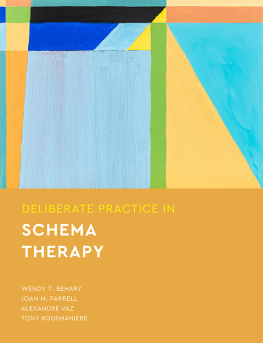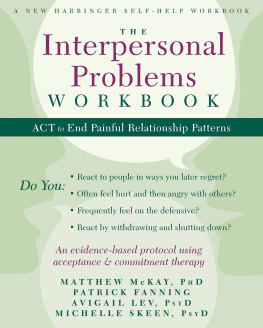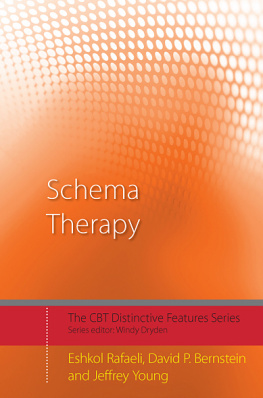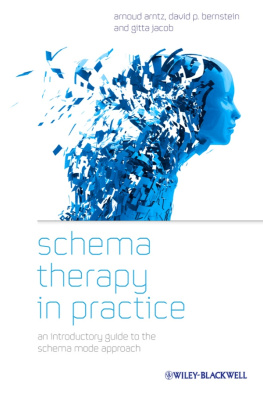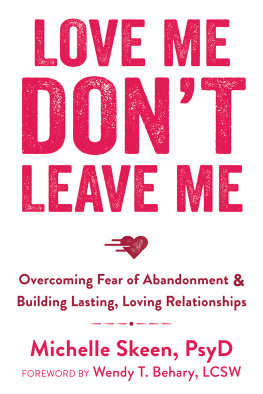
CONTENTS
List of Tables
- Chapter 02
- Chapter 05
List of Illustrations
- Chapter 02
- Chapter 03
- Chapter 04
- Chapter 06
- Chapter 07
- Chapter 08
- Chapter 09
- Chapter 10
Guide
Pages
Breaking Negative Thinking Patterns
A Schema Therapy Self-Help and Support Book
Gitta Jacob, Hannie van Genderen and Laura Seebauer
This edition first published 2015
2011 Beltz Psychologie in der Verlagsgruppe
Beltz Weinheim Basel
Registered Office
John Wiley & Sons, Ltd, The Atrium, Southern Gate, Chichester, West Sussex, PO19 8SQ, UK
Editorial Offices
350 Main Street, Malden, MA 02148-5020, USA
9600 Garsington Road, Oxford, OX4 2DQ, UK
The Atrium, Southern Gate, Chichester, West Sussex, PO19 8SQ, UK
For details of our global editorial offices, for customer services, and for information about how to apply for permission to reuse the copyright material in this book please see our website at www.wiley.com/wiley-blackwell.
The right of Gitta Jacob, Hannie van Genderen and Laura Seebauer to be identified as the authors of this work has been asserted in accordance with the UK Copyright, Designs and Patents Act 1988.
All rights reserved. No part of this publication may be reproduced, stored in a retrieval system, or transmitted, in any form or by any means, electronic, mechanical, photocopying, recording or otherwise, except as permitted by the UK Copyright, Designs and Patents Act 1988, without the prior permission of the publisher.
Wiley also publishes its books in a variety of electronic formats. Some content that appears in print may not be available in electronic books.
Designations used by companies to distinguish their products are often claimed as trademarks. All brand names and product names used in this book are trade names, service marks, trademarks or registered trademarks of their respective owners. The publisher is not associated with any product or vendor mentioned in this book.
Limit of Liability/Disclaimer of Warranty: While the publisher and authors have used their best efforts in preparing this book, they make no representations or warranties with respect to the accuracy or completeness of the contents of this book and specifically disclaim any implied warranties of merchantability or fitness for a particular purpose. It is sold on the understanding that the publisher is not engaged in rendering professional services and neither the publisher nor the author shall be liable for damages arising herefrom. If professional advice or other expert assistance is required, the services of a competent professional should be sought.
Library of Congress Cataloging-in-Publication data applied for.
Hardback ISBN: 9781118877722
Paperback ISBN: 9781118877715
A catalogue record for this book is available from the British Library.
Cover image: Daniel Vin, Visages Multiples; courtesy of foxx galerie, Zurich, www.foxxgalerie.com. Background RapidEye / iStockphoto
Preface
Are you familiar with the experience of negative thinking patterns keeping you from attaining your personal goals? With this book we want to help you understand yourself, your feelings, and your personal patterns better. Your negative thinking patterns are the beaten track which you have walked many times. If you want to find new ways, you should understand the origins of your beaten track and why you take it again and again. The first part of this book is all about understanding negative thinking patterns, and the related emotions and behaviors. In the second part we will explain in detail how you can change these patterns, if you consider a change necessary or reasonable.
We base our explanations on the so-called Schema Mode approach. This is the latest development in Schema Therapy, which was developed by Jeffery Young and colleagues in New York (2006) and is rapidly spreading around the globe. Many therapists are enthusiastic about schema therapy, as it integrates experiences and techniques from various therapeutic approaches very effectively. Not only thoughts but also feelings are taken into consideration, and current problems are of interest as well as their origin in childhood. This usually gives clients the impression of work being done on the core of their problems in an easy and understandable way. In work with schema modes, clients and therapists are at eye-level. Both parties are looking for better ways to meet clients needs.
In this book we try to go through the Schema Mode approach in an understandable way for anyone who is interested. We want to encourage you to change your patterns in such a way that negative feelings will weaken and positive feelings get more space in your life. To attain this goal, you will need to reduce disadvantageous coping strategies for negative feelings. You can use this book either as a self-help book or as assistance to a (Schema-) therapy. Psychological technical terms which may not be familiar to you are printed in bold and explained in the Glossary. You can download and print all worksheets from the books website (www.wiley.com\go\Jacob\breakingnegativethoughtpatterns). More detailed instructions are provided at the end of the book.
This book project is part of a long-standing cooperation and exchange program of the University of Freiburg (Germany), the Regionale Instelling voor Ambulante Geestelijke Gezondheidszorg (RIAGG) in Maastricht and the University of Maastricht (Netherlands). This cooperation, which offered us many interesting insights and common projects, has been a pleasure throughout its duration. We thank Darren Reed and his colleagues from Wiley Blackwell for their effective and committed support. Claudia Styrsky drew the wonderful cartoons in this book we could not get enough of them! Last but not least we say thanks to our husbands and families for being so tolerant (again) to help us devote so many week-ends and so much precious free time to this project!
Hamburg, Maastricht und Freiburg, Autumn 2014
Gitta Jacob, Hannie van Genderen, Laura Seebauer
Credit for Images
Illustrations are by Claudia Styrsky, Mnchen.
Introduction
Case Example Exclusion
Carol is a 34-year-old mother of a 4-year-old son, in a stable relationship. She works part-time as a bank assistant. She could be quite satisfied with her life, but minor incidents sometimes trigger severe feelings of exclusion or rejection. This may happen, for example, when her colleagues who work full-time make an insider joke she doesnt get. Most often, she reacts by drawing back from them. But she may also respond like a stroppy child to her colleagues, in particular when she is having a bad day anyway. Then she is not only annoyed by her colleagues, but also feels ashamed of her own reaction.
Carol has had this kind of problem all her life maybe it has something to do with her childhood. Because of her fathers frequent job changes, she was forced to move and start all over again several times. Facing a new school class, she often made the experience of feeling excluded. At the age of 12, she even experienced severe mobbing in school.
Does that sound familiar to you? Persistent patterns you just cannot get rid of? The same kind of feelings mixing up your life over and over again?
Next page

